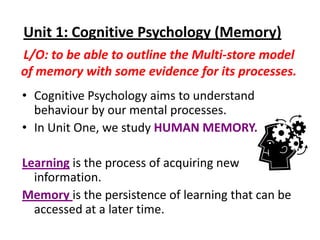
Multi store model of memory
- 1. Unit 1: Cognitive Psychology (Memory) L/O: to be able to outline the Multi-store model of memory with some evidence for its processes. • Cognitive Psychology aims to understand behaviour by our mental processes. • In Unit One, we study HUMAN MEMORY. Learning is the process of acquiring new information. Memory is the persistence of learning that can be accessed at a later time.
- 2. The Multi-Store Model of Memory (Atkinson and Shiffrin, 1968) • First attempt to explain making a memory like the one you just tried. • Formulated a structure for memory. • 3 components: CAPACITY: amount that can be held in STM (Jacobs, 1890; Miller, 1956) decay Short-term Long-term Sensory memory memory memory ENCODING: changing info to a memorable format = sound (Conrad, 1964). DURATION: how long it can be held in STM (Peterson & Peterson, 1959).
- 3. • What was the difference in the two tasks? • Was your memory better for the first 5 or the second 5 items? Attention! Why would that make memory better?
- 4. Eye-conic! • Echoic memories go into the echoic store. • Sound memories. • Iconic memories go into the iconic Decay time = several store. seconds. • Sight memories. Decay time = ½ a second. Hear an echo-ic!
- 5. The Multi-Store Model of Memory (Atkinson and Shiffrin, 1968) We get bombarded with sensory information all day long. Our attention mechanism selects some of the information. The rest is decayed – lost. CAPACITY: amount that can be held in STM (Jacobs, 1890; Miller, 1956) decay Short-term Long-term Sensory memory memory memory ENCODING: changing info to a memorable format = sound (Conrad, 1964). DURATION: how long it can be held in STM (Peterson & Peterson, 1959).
- 6. Research associated with MSM Short-term Memory STM: • Conrad (1964) pg. 62 • Jacobs (1890) pg. 63 • Peterson & Peterson (1959) pg. 64 Take notes on: Long-term Memory LTM: • What they wanted to test (aim/hypothesis). • Bahrick et al (1975) pg. 67 • What they did. • Who took part. • What they found.
- 7. Friday 21st September 2012 Sharing notes on the research for MSM. • You have detailed notes on one or two of the four studies. • Group together with people who have taken notes on different studies. = all have notes on all four. *try to use your research methods knowledge and terminology when presenting* (e.g. participants, population, sample)
- 8. Short-term Memory STM 1. Get definitions for these terms. Which studies are evidence for which? • Capacity: Which study? Peterson & Peterson (1959) • Encoding: Jacobs (1890) Conrad (1964) • Duration: Which does Bahrick’s study provide evidence for? (in LTM)
- 9. Semantic Memory • Semantic = meaning. • Acoustic = sound. For example: Chair vs. table Chair vs. stair
- 10. Come up with a semantically related word to help you to remember these symbols.
- 11. L/O: to be able to outline the Multi- store model of memory with some evidence for its processes. Can you? • Example exam question: Outline the Multi-store Model of memory (4 marks)
- 12. Evaluation of the Multi-store Model of Memory L/O: to be able to outline and evaluate the MSM of memory. Starter: • Try to draw the MSM diagram from memory.
- 13. The Multi-Store Model of Memory (Atkinson and Shiffrin, 1968)
- 14. The Multi-Store Model of Memory (Atkinson and Shiffrin, 1968) CAPACITY: amount that can be held in STM (Jacobs, 1890; Miller, 1956) decay Short-term Long-term Sensory memory memory memory ENCODING: changing info to a memorable format = sound (Conrad, 1964). DURATION: how long it can be held in STM (Peterson & Peterson, 1959).
- 15. L/O: to be able to outline and evaluate the MSM of memory. The STM store in the model Chunking: changing the size of items by reorganising information e.g. 07958-245- 124 becomes 3 ‘items’. CAPACITY IN STM Interference: any gap / time/ distraction in memory model process e.g. a task in between list of words to be remembered. DURATION IN STM
- 16. L/O: to be able to outline and evaluate the MSM of memory. The STM store in the model Rehearsal Maintenance rehearsal: simply repeating information = keeps it in STM. Elaborate rehearsal: using the info and changing it = transfer to LTM. How could you apply these types of rehearsal to your experience of learning? Discuss and write a sentence or two using the terminology of the two types of rehearsal.
- 17. L/O: to be able to outline and evaluate the MSM of memory. The LTM store inisthe model errors This why semantic occur for things we know well (LTM) Encoding is present when information goes from the STM to LTM too.barn – shed. e.g. It is very rare for acoustic Short-term Long-term errors to occur in our LTM Sensory memory memory memory e.g. ENCODING: barn – born ENCODING: Sound Meaning (acoustic) (semantic)
- 18. EXAM TIP! You may be asked about the differences between encoding, capacity and duration in STM and LTM in the MSM. • Textbook p.g. 65. • Read and copy table of differences.
- 19. Evaluation of the MSM • Strengths (evidence for it) • Weaknesses 1. Studies of brain damaged (evidence against it) patients have suggested that the STM and LTM are two separate stores in the brain (Shallice & Warrington – KF). 2. Murdock - Primacy effect (remember first few of a word list): support for rehearsal in STM; Recency effect (remember last few of a word list): support for duration in STM.